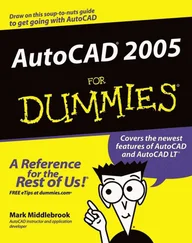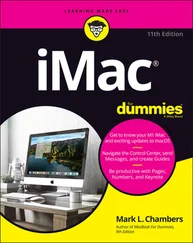 Navigating safe handling of animal proteins
Navigating safe handling of animal proteins
 Relying on science
Relying on science
There is nothing worse than sitting down to dinner where someone at the table starts a conversation about something, dare I say, gross. You know what kind of topics I’m talking about: things that would be considered uncouth. For the sake of manners, make sure you aren’t sitting at the dinner table when you dig into the next few pages. When it comes to food handling, safety must be of paramount importance to you. In fact, you can’t be a good food artisan if you can’t manage basic hygiene and sanitation. It is so easy to make yourself sick if you don’t take every possible precaution when handling food.
I’ll take it a step further, though. When it comes to working with potentially hazardous food, like meat, there are additional safeguards that must be in place to ensure your safety as well as the safety of anyone who may ingest your creations. Think I’m joking? According to the Centers for Disease Control and Prevention (CDC), in 2016 there were an estimated 36 million cases of foodborne illness in America. That means that approximately one in every ten people got sick once that year from food. About 30 million of those cases could have been avoided simply through adherence to a proper personal hygiene program in and outside of the kitchen ( https://www.cdc.gov/foodborneburden/pdfs/scallan-estimated-illnesses-foodborne-pathogens.pdf ).
I won’t bore you with the details here (that’s for later); in this chapter you will learn basic sanitation, hygiene, and safe food handling skills. You will also learn about pathogens of concern and how to safeguard against them with strategies backed by science.
As a kid, I used to get so irritated when my parents would harp on me to wash behind my ears and in my belly button (God must have used a melon baller when he made my belly button). But this isn’t the type of personal hygiene that is of concern here. Well, it is and it isn’t. Before you can even think about working with food meant for human consumption, you need to be thinking about cleanliness and sanitation, and that starts with you. Hand washing is the first thing that you should do. According to the Food and Drug Administration (FDA), you should wash your hands with warm water and lather up with antibacterial soap for at least 12 seconds before rinsing and drying your hands with a single-use towel. So count them off: one-Mississippi, two-Mississippi, you get the point! Once you’ve washed your hands, consider yourself scrubbed in for surgery.
 Here is a list of activities that will (should) trigger a rewash:
Here is a list of activities that will (should) trigger a rewash:
Touching your phone
Touching your face
Touching your hair
Touching money
Putting your hands in your pockets
Touching a door handle
Touching trash
Eating food
Sneezing or coughing into your hands
Before or when changing gloves
I could go on, but I’m sure you get the point. Keep your hands clean.
Wearing an apron isn’t nearly as obvious as ritual handwashing may be, but it is definitely important. The clothes you are wearing are likely to have come into contact with all sorts of potential contagions throughout the day. If the food you are working with happens to come into contact with your clothing, then you can consider it contaminated. An easy way to deal with this is by wearing an apron like the one pictured in Figure 2-1.
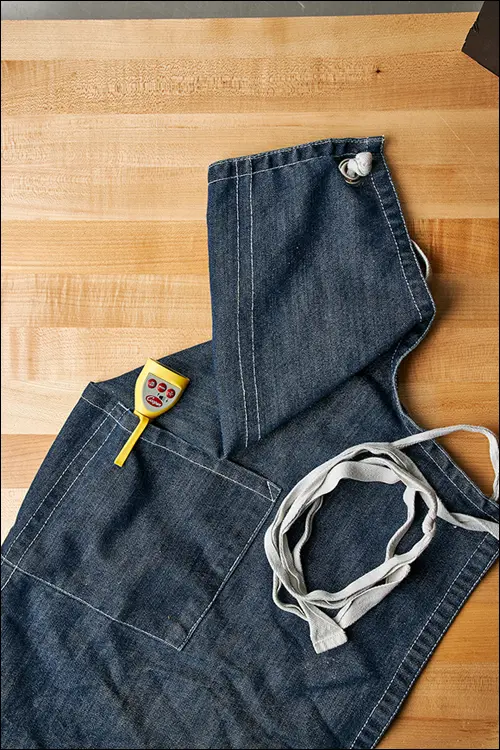
Photo by David Pluimer
FIGURE 2-1:A standard kitchen apron.
Before putting on your apron, make sure it is clean and hasn’t been used prior to you putting it on. Not only will the apron keep you clean when working with food, but it will also protect your food against unintended contamination.
You know this has happened to you before. You went out to lunch, and took a bite of your mac and cheese only to be startled by a sudden flossing sensation. Hair in food isn’t sanitary and it isn’t appetizing. A proper hair restraint will save you and your family from the unintended gross-out of finding a hair in your sausage. A simple hair net, baseball cap, or sock hat will work. If you have long hair, pulling it back and putting it up will be critical as well.
Since working in food service, I’ve grown accustomed to using food-safe gloves for almost everything I do with food, regardless of whether it’s at work or at home. Food-safe gloves are an extra barrier of protection. They aren’t as necessary when handling food that must be cooked before it can be eaten. They are, however, an absolute necessity if you are handling food that is ready to eat, like salamis and whole-muscle charcuterie, which I discuss later in this book. Figure 2-2 shows some food-safe gloves.

Photo by David Pluimer
FIGURE 2-2:Stay safe with food-safe gloves.
Gloves meant for food handling can be plastic or latex, and they can be powder lined or powder free. The powder makes it easier to slip the gloves on if your hands are still slightly damp from you washing them before putting them on.
Before you start handling food, you need to make sure that your work area and tools are all cleaned and sanitized. In a commercial setting, this is called a pre-op , which is short for pre-operational. At this point you will need to fill a small bowl or bucket with soapy water and another bucket with sanitizer, which can be a blend of bleach and water. You also need a separate clean towel to use with each bucket.
 You can disinfect with a solution of one tablespoon of bleach to one gallon of cold water. If it’s hot, the chlorine will evaporate off, so be sure to use cold water.
You can disinfect with a solution of one tablespoon of bleach to one gallon of cold water. If it’s hot, the chlorine will evaporate off, so be sure to use cold water.
Once your cleaner and sanitizer buckets are ready to go, clean down each work surface with the soapy water and then wipe it down with the sanitizer.
Once you have cleaned and sanitized each surface, clean and sanitize all of the tools and equipment you intend to use. These include knives, cutting boards, bowls, and any other object or device that will come in contact with food. Last but not least, you will want to visually inspect any device you will be using, like your grinder or stuffer, to make sure there aren’t any food particles that you missed the last time it was cleaned and put away.
One way to avoid missing any of these details is to put together a prep list, like the one shown in Figure 2-3. You can print this list and have it in the kitchen for when you get started, and then simply check off the items as you clean and sanitize them.
Once you’ve checked everything off your list, you’re ready to get started.
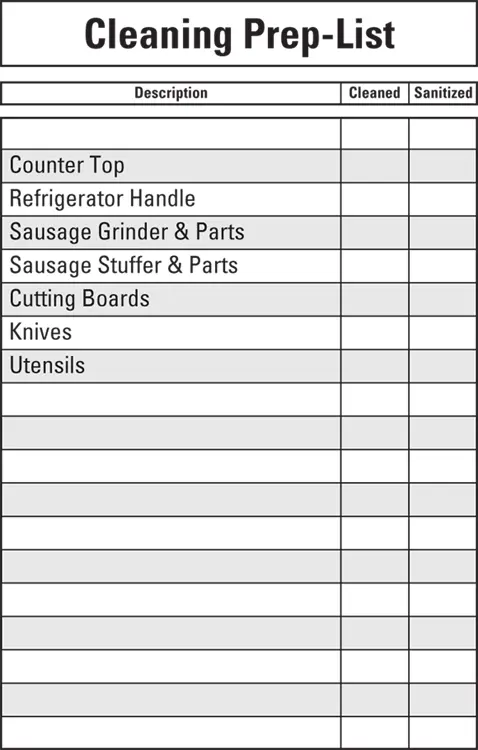
Mark LaFay
Читать дальше
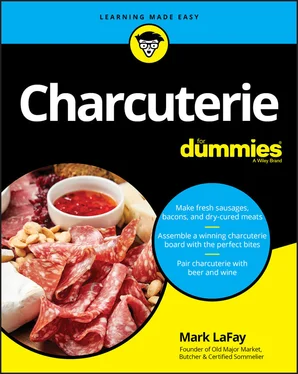
 Navigating safe handling of animal proteins
Navigating safe handling of animal proteins Here is a list of activities that will (should) trigger a rewash:
Here is a list of activities that will (should) trigger a rewash:


